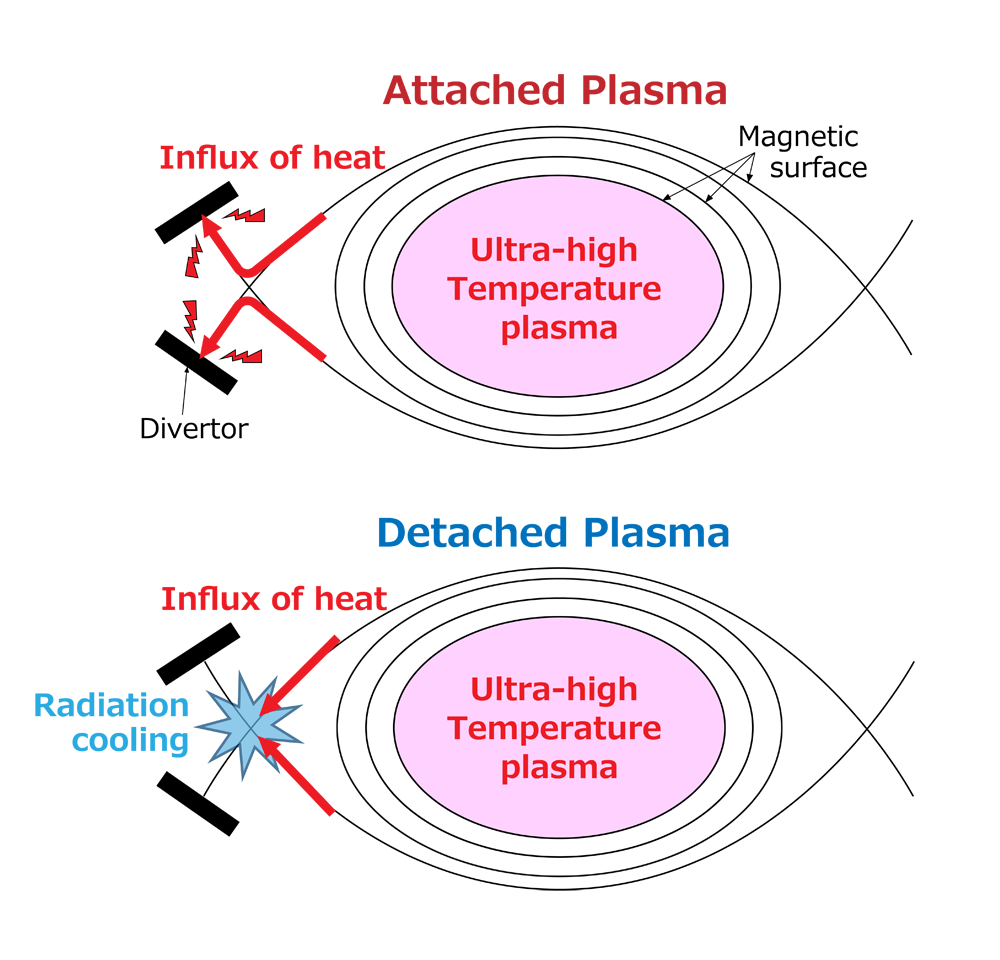Identification of the condition to cease plasma heat flux by machine learning
In experiments conducted with the Large Helical Device (LHD), the conditions under which the influx of heat due to plasma along the magnetic field lines ceases have been identified for the first time, using machine learning. This phenomenon is called "detachment." While detachment is an operational prerequisite for protecting fusion reactors, it involves various and complex conditions. By applying machine learning to a variety of experimental conditions, we have succeeded in identifying the necessary operational environments for this phenomenon for the first time. This achievement is the result of research conducted by a graduate student at the University of Tokyo.

In a fusion reactor, deuterium and tritium fuse to form helium, which is essentially ash, and must be removed from the burning plasma. The plasma is kept from contacting the walls by a magnetic cage (magnetic surface) in order to maintain ultra-high temperatures. However, in order to remove the ash, a part of the magnetic cage is intentionally opened. This complex is called the divertor. Since the plasma directly contacts the divertor, there is a serious influx of heat, which places a heavy load on the components. Reducing this thermal load is a critical issue that must be addressed in order to make fusion reactors viable.
A promising fundamental solution is the detached plasma operation. This method involves cooling the plasma by losing energy as radiation (a process called radiative cooling) before the plasma reaches the divertor along the magnetic field lines, turning it into gas. By doing this, the high-temperature plasma no longer comes into contact with the structure (detachment), significantly reducing the influx of heat. However, since the outer edge region of the plasma is cooled down, if not carefully managed, this low-temperature state can propagate upstream along the magnetic field lines and degrade the ultra-high temperature plasma in the core.
In the Large Helical Device (LHD), by adjusting the magnetic field so that the surrounding magnetic field lines do not form a single line but rather a pattern resembling a string of beads, we have successfully achieved stable detached plasma without cooling the ultra-high-temperature plasma in the core. However, while it is empirically known that detached plasma occurs under conditions of high density, where radiative cooling is amplified, or when heating power is small and the temperature does not rise significantly, the specific conditions under which detachment occurs have not been described until now.
In this study, we used machine learning methods, specifically Support Vector Machines (SVM) and Exhaust Search, to determine the conditions for detached plasma. This approach involved gathering parameters that seemed to distinguish between the two states (here, attached and detached plasma) and using them to derive a simple equation with excellent separation performance. Specifically, we selected 15 parameters that could either be adjusted by the experimentalist or measured, and through analysis, we found that an equation expressed by five parameters—density, magnetic field strength, heating power, radiative power, and plasma response to peripheral magnetic field adjustments (characteristic magnetic flux changes)—could almost completely separate the two states. Additionally, by injecting a small amount of impurity gas (neon) other than fuel hydrogen, we could increase the radiative power even at the same density. It was confirmed that this separation equation remained effective even with such intentional control.
Furthermore, although this separation equation was derived from machine learning without physical consideration, reflecting on what its expression implied provided hints for hypothesizing the physical processes behind detached plasma. However, the equation only distinguished between the two states and did not indicate any causal relationship. To address this, in this study, we used another machine learning method related to pattern recognition to detect abnormal changes in the time evolution of parameters that were likely to be key to the transition to detached plasma. We investigated the sequence of these changes and found a significant degree of commonality in them, despite various operating conditions. While this sequence of changes did not necessarily indicate causality, it served as an important clue when considering physical models.
The equation representing the conditions under which detached plasma occurs is expressed as a simple power-law, which can be applied to draw an operational scenario and have control in the experiment. Detached plasma operation is not limited to the helical configuration but is also a critical issue common to tokamaks. Including the achievements related to anomaly detection, it is expected that the successful methodology developed in this study will be applied, contributing to the establishment of the safe operation of fusion plasma.
This research result was published in Plasma and Fusion Research, an online journal by the Japan Society of Plasma Science and Nuclear Fusion Research, on January 14, 2025.
